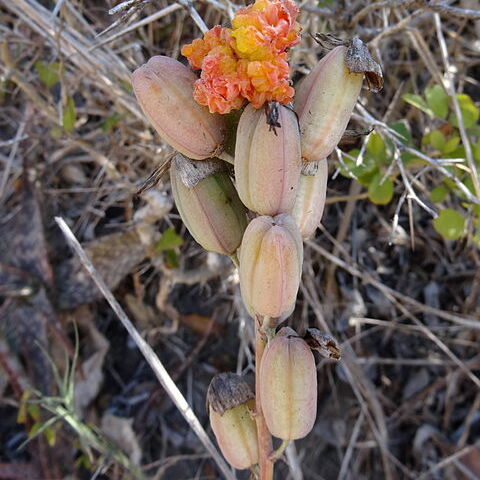Plants with very short stems, freely suckering, forming dense groups. Leaves 10-15, spreading, recurved, narrowly lanceolate, 30-40 cm long; adaxial surface green to brownish green with numerous white spots; abaxial surface pale green with few dull white spots; margins with brown teeth 3-5 mm long. Inflorescence branched, 1-1.5 m tall; scape subtended by deltoid bracts 19 mm long. Racemes 3-6, 7-17 cm long, 6-8 cm wide; flowers not crowded; bracts deltoid-acuminate, 12-15 mm long; pedicels 8-14 mm long. Perianth cylindrical-trigonous with basal swelling near ovary, 30-33 mm long, orange-pink; sepals and petals subacute to obtuse, spreading to recurved, cohering for part of their length. Stigma exserted 1-2 mm. Capsule 3.5-4 cm long. Seeds 3-4 mm long, 2-3 mm wide, grey.
Plants stemless or very short-stemmed, 200-400 mm tall excluding inflorescence, suckering freely to form large, dense groups. Leaves 10-15 per rosette, spreading to decurved, 300-500 x 30-80 mm, slightly channelled, upper surface with many whitish spots in irregular transverse bands, lower surface usually unspotted. Inflorescence with 4-9 ultimate branches, 1.0-1.5 m tall; racemes cylindric, sublax; bracts deltoid-cirrhous, ±9-12 x 3 mm, 5-7-nerved. Flowers dull red, 24-33 mm long, mouth downtumed; outer segments free for 8-10 mm, inner segments dorsally adnate to outer; pedicels 7-17 mm long. Anthers exserted 1-2 mm. Ovary 7.0-10.0 x 2.5-3.5 mm, green; style exserted 1-2 mm. Fruit 20-23 x 11-13 mm, purplish brown.
Leaves in a compact flattened rosette, spreading widely; lamina 20–40 cm long, 3–8 cm wide toward the base, lanceolate, dark brownish-green, with conspicuous oblong whitish spots more or less in transverse bands on the upper surface, usually spotted on the lower surface; margin with pungent deltoid brown-tipped teeth 3–5 mm long, 8–15 mm apart; sap purplish.
Perianth dull-red with pale margins to the segments to ± halfway, 25–30 mm long, c. 7 mm in diameter across the ovary, constricted just above then widening and becoming slightly decurved, cylindric-trigonous; outer segments free for one-third with widely spreading tips.
Acaulescent or very shortly caulescent, succulent herb, 200-400 mm tall, in clumps. Leaves spotted on upper surface only, spots in transverse bands. Perianth with tube cylindrical, mouth downturned. Flowers dull red.
Inflorescence erect, 0.5–1.5 m high; peduncle slender, 3–8-branched, the lowest branches occasionally rebranched; branches suberect, subtended by scarious bracts to 2 cm long.
Racemes 10–20 × 7 cm, cylindric, laxly flowered; bracts c. 8–12 × 2 mm, linear-lanceolate; pedicels 8–14 mm long.
Perennial herb, suckering to form large groups of plants, acaulescent or with a short thick stem to c. 5 cm long.
A herb. It keeps growing from year to year. It does not have a stem. It develops suckers to form clumps.
Seeds c. 2.5 × 6 mm, black with pale brown wings.
Capsule c. 25 × 11 mm, oblong-ovoid, greyish.
Stamens and stigma slightly exserted.


